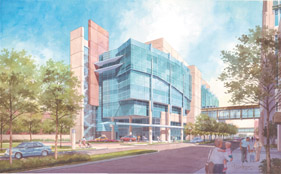Chicago:
Campus of the Big Ideas
>> The
launch of The Chicago Initiative-the University's five-year, $2
billion fund-raising effort-was marked by an April 12 event that
focused on Chicago's intellectual initiatives.
Chicago
Initiative Goals
1.
Strengthen a Community of Scholars and Teachers
The
first of the Chicago Initiative's four priorities goes to the
heart of the University: $275 million to provide funds to recruit
and retain the world's most exciting teachers and scholars and
to provide the faculty with first-class research tools and resources.
The goal includes 35 endowed professorships and funds for visiting
professors, guest artists, term appointments, and lectureships.
2.
Ensure Access to a Chicago Education
The
Chicago Initiative has targeted $290 million to help the University
meet its long-standing commitment to a need-blind admissions policy,
one that brings to the University the brightest undergraduate
and graduate students regardless of their financial background.
Nearly
half of Chicago's undergraduates require financial aid, with an
annual average need-based grant of $14,000 per student-a drain
on a University budget that also must compete for the nation's
most talented Ph.D. students, who typically receive offers that
include full tuition, a substantial stipend, and, increasingly,
fringe benefits such as health insurance.
3.
Transcend Barriers in Science and Research
Almost
half of the Chicago Initiative's $2 billion goal-or $955 million-is
earmarked for facilities, equipment, and programs in the physical
and natural sciences. Just as Chicago made an indelible mark on
the science of the 20th century-from developing carbon-14 dating
to proving that chromosomal defects can lead to cancer-so the
University hopes to lead the scientific advances of the 21st century.
A
key element will be the Interdivisional
Research Building (IRB). By bringing together biological
and physical scientists under one roof, in 425,000 square feet
of research space, the IRB will make it easier for Chicago's researchers
to break down the boundaries of traditional scientific disciplines.
Three
main areas of support are sought: $445 million for research support
(including funds for laboratories and scientific equipment), $380
million for core research-oriented programs in the biological
and physical sciences, and $130 million for facilities, including
the IRB and the Comer
Children's Hospital, a new 155-bed facility scheduled
to open in early 2004.
|
|
|
Comer Children's Hospital
|
4.
Cultivate the Landscape for Learning through the Master Plan
Finalized
in 1999 the University of Chicago Campus Master Plan outlines
crucial physical-space needs-and sets forth a plan for meeting
those needs that reinforces a University-wide commitment to creating
a campus that maximizes the intersection of people and ideas.
$390 million is targeted to help turn the plans into reality.
On
the drawing board-and, in two cases, already under construction-are
three major projects:
-
A
$125 million, 400,000 square foot Graduate
School of Business campus has been designed by
Rafael Viñoly to encourage discussion, debate, and
creative collaboration, bringing together people now scattered
throughout four different buildings to a location in the center
of the main campus.
-
The
Gerald Ratner Athletics Center, scheduled to open
in fall 2003, meets increasing demand for intramural, club,
and varsity sports, as well as physical fitness and recreational
use. Designed by Cesar Pelli, the center will include an Olympic-regulation
pool, fitness center, workout rooms, dance classrooms, and
a 2,500-seat gymnasium that will do double duty for special
events and sports competitions.
-
New
creative and performing arts facilities
are in the planning stages. Building on Chicago's interdisciplinary
tradition, the facilities will emphasize intermedia exchange
through new and expanded spaces for the visual and performance
arts.
Annual
Funds
Year-in,
year-out, the annual gifts of alumni and friends to the University
have enormous impact-in 2001, for example, alumni and friends
made annual gifts totaling more than $13.7 million, providing
ongoing support for student scholarships and graduate fellowships,
faculty research and teaching programs, and research and computer
labs.
Providing
the institution with the greatest flexibility to support its academic
mission, all gifts to the annual funds of each division, unit,
or school throughout the Chicago Initiative will be included in
the Initiative totals. The goal: $90 million.
1.
In
the beginning: what do our origins tell us about ourselves?
2.
Homo sapiens: are
we really rational creatures?
3.
Integrating the
physical and biological sciences: what lies ahead?
4.
Money,
services, or laws: how do we improve lives?
5.
Clones, genes, and
stem cells: can we find the path to the greatest good?
6.
How will technology change
the way we work and live?
7.
Why do we dig up
the past?
8.
Art for art's sake?
9.
In the realm of
the senses: how do we understand what we see, hear, feel, smell,
and taste?
10.
Can we protect
civil liberties in wartime?
CHICAGO
INITIATIVE GOALS


![]()
